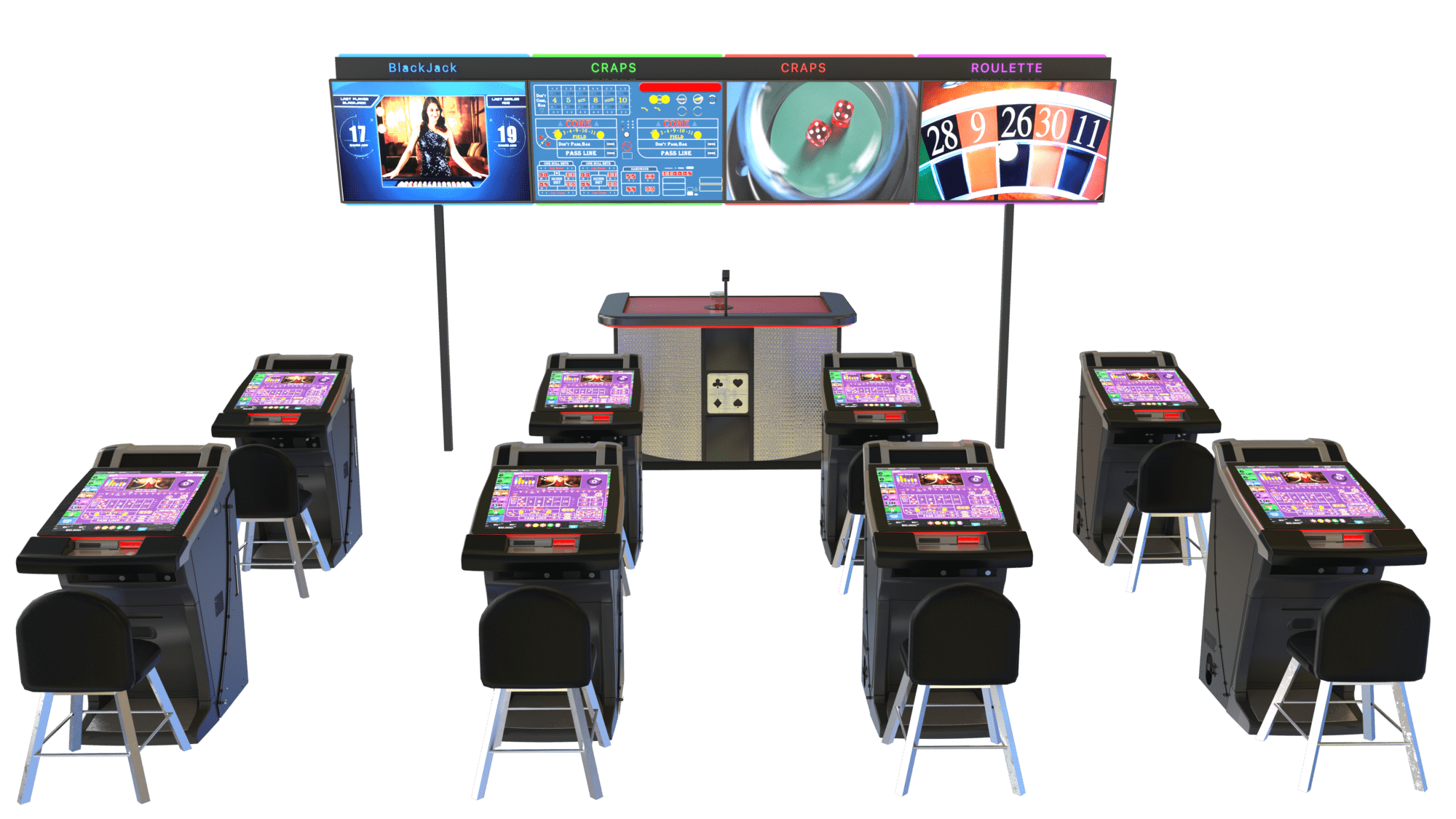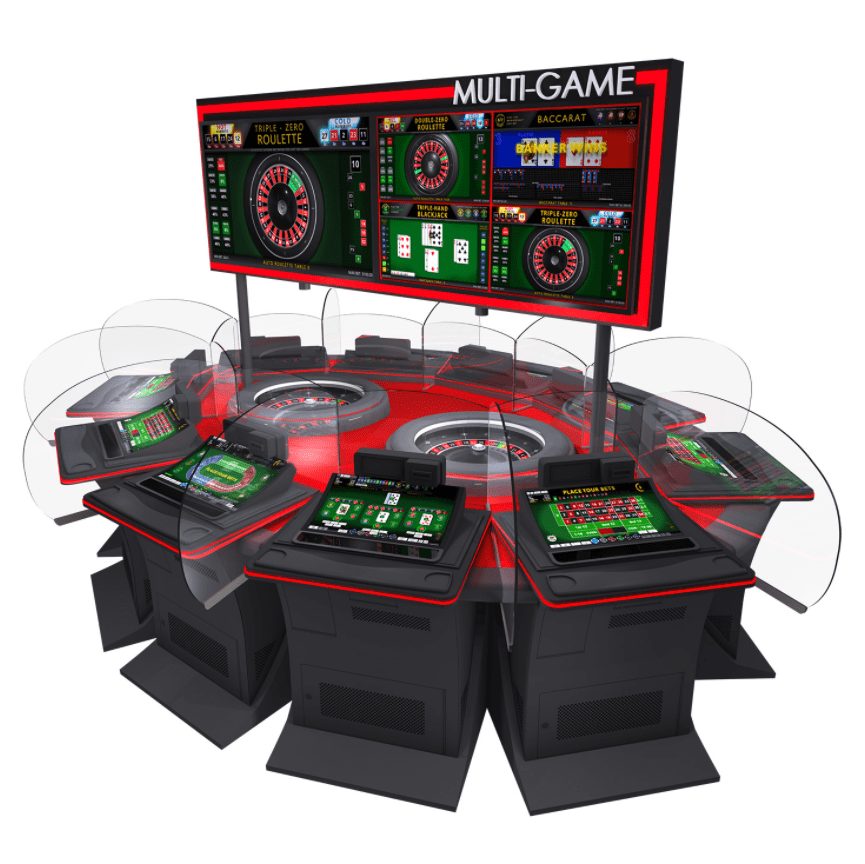Restrictions amid the pandemic boost what was already strong growth in the adoption of electronic table games.
Even before the global pandemic took off last year, electronic table games were on the rise as a product segment, with casinos carving out special sections for ETGs, many in lounge settings or featuring live dealers running games fed to sometimes hundreds of terminals.
Electronic table games first appeared in Europe in the 1990s and were largely a function of space—small casinos could offer multi-terminal automated roulette games, which grew quickly in markets like Slovenia, where Interblock was the first leader, arguably inventing the product genre. As casinos expanded across North America in that same decade, the ETG found new homes in markets that had not legalized table games.
Other markets found ETGs a great hybrid product between slot machines and table games, and a way for novice players to learn tables without intimidation. The traditional slot manufacturers got into the game. International Game Technology released the M-P (for multi-player) series in 2006, and within a decade was catering to growing demand with its Dynasty series of ETGs, and, more recently, the Peak Terminal. Scientific Games’ legacy company, Shuffle Master, achieved great success with ETG versions of its proprietary table games and traditional games in its Table Master series.
As casino audiences skewed younger in more recent years, ETGs became a draw for young players who gravitated more to table games involving skill and multi-player socialization—and because the minimum bets were a fraction of what was found in the live pit. The ETG evolved as Aruze introduced its Shoot to Win Craps, and, more recently, Roll to Win Craps, the first products to find success in electronic versions of the classic dice game.
Interblock Luxury Gaming Products, the Slovenia-based company that was instrumental in starting the ETG genre, has remained dominant in the genre with stadium-style setups that have created unique gaming areas. These range from gaming ultra-lounges using its Pulse Arena product to attractions like the R Bar at the Cordish Live! casinos, which are sports-themed attractions with live dealers at the front operating games played on terminals that allow for up to four different e-table games to be played at once.
All of this growth in the ETG genre occurred before the pandemic brought on the Great Shutdown a year ago. As casinos reopened following the first wave of shutdowns, there were new reasons for casinos to stock up on the hybrid product, from lingering hesitance to return to a crowded table to overall capacity limitations that made it difficult—and very expensive—to play at the tables that were open.
“The demand for ETGs has increased as casinos reopen, but not for the reason of people being afraid of returning to live tables,” commented Rob Bone, senior vice president of global systems and tables at Scientific Games. “Many operators are still under capacity restrictions, and have limited seating at their felt games for players to sit at. Generally, this leads the table minimums to be much higher to offset the labor cost.
“Since we can socially distance our ETGs, it allows operators to offer a table game experience to their players while maximizing the labor cost of maintaining the dealer for the game, as well as offer a low-denom alternative for the more novice players.”

Paul Baskerville
“The demand for IGT’s ETG hardware and content portfolio was on a growth trajectory before COVID-19, and the pandemic only accelerated that trend,” said Paul Baskerville, IGT’s director of product management for electronic table games. “ETGs’ capacity to help operators overcome social distancing mandates, decrease labor costs, and reduce cash and chip handling instantly elevated their relevance in the minds of both operators and players.”
Aruze’s Roll to Win Craps product has provided a COVID-safe alternative to what is normally one of the most crowded operations on the casino floor. “Demand for ETGs was already strong, and being able to offer players a table game experience at a reduced risk has added to that demand,” said Fred Nunez, Aruze’s director of global product management. “People still want to play table games; they just want to be safe about it, and Roll to Win Craps allows them to do both.”
Continuing the Trends
From all appearances, the trends that were prevalent in ETGs have picked up where they left off before the pandemic, as the game genre’s popularity has surged.
“The latest trends in ETGs are the ability to operate stadiums in a dealer-assisted and automated mode, new game content and stand-alone terminals,” said Scientific Games’ Bone. “For example, in a stadium environment, players can choose to play the automated roulette wheel game or the dealer-assisted roulette live game, or both at the same time. Our library is expanding to include new game variants and more table game content that is currently offered on our live tables to allow more variety for players.”
“There seem to be three major trends in ETGs: hybrid games, physical components and extended seating,” says Aruze’s Nunez. “Hybrid or dealer-assisted games allow the dealer to be part of the game experience. That key interaction with players allows them to be connected with a casino brand in a different way than they might otherwise.”
“There are a few widespread trends that are helping drive demand for IGT’s ETG products,” said Baskerville. “First, IGT’s ETGs immediately address some of the pandemic-related challenges and restrictions that gaming venues around the world must navigate.
“ETGs, such as IGT’s Peak Terminal, accommodate social distancing better than traditional table games. They can be deployed in a range of configurations and in varied locations throughout a casino floor. Additionally, ETGs enable a reduced-contact environment, void of casino chips and live dealers in close proximity to players, both relevant benefits in the minds of operators and players in the current casino climate.
All of the ETG manufacturers provide both fully automated units utilizing a random number generator for game results and the live-dealer hybrid variations in which live action determines the results. Trends between the two vary according to the supplier and the market.
 “Operators have recently preferred RNG-based products over the live-dealer products,” said SG’s Bone. “COVID restrictions have varied for each property, and we feel that this has led to the increased desire for RNG-based outcomes on ETGs. Our Quartz Hybrid product provides the flexibility to operate all games in either a live-dealer mode, RNG mode or both modes at the same time. Over the past year, we are seeing players warm up to the RNG-based ETGs as they learn more about how to play the RNG games.”
“Operators have recently preferred RNG-based products over the live-dealer products,” said SG’s Bone. “COVID restrictions have varied for each property, and we feel that this has led to the increased desire for RNG-based outcomes on ETGs. Our Quartz Hybrid product provides the flexibility to operate all games in either a live-dealer mode, RNG mode or both modes at the same time. Over the past year, we are seeing players warm up to the RNG-based ETGs as they learn more about how to play the RNG games.”
The Quartz Hybrid setup offers players up to eight games on a single terminal. “Although players do not play every available game, they do like the flexibility to choose the games they want to play,” Bone said. “We offer a wide library of games and each game can be configured to play according to the house rules.”
“We’ve found preferences for RNG versus live-dealer products to be very market-specific,” commented IGT’s Baskerville. “Generally speaking, in more resort-based areas, IGT customers and players alike trend more towards live-dealer ETGs, given that they closely resemble a more traditional table game through an actual dealer spinning a physical roulette wheel and dealing real playing cards for blackjack and baccarat.
“Meanwhile, at regional, locals-based properties, the movement often skews toward RNG-based products. The RNG suite of games, whether virtual, automated or a combination of both, benefit operators through a reduction in dealer labor. Covid-19 has engendered tougher restrictions on traditional table games, mostly through reduced player positions, making it more difficult for regional and locals-based properties to get the necessary yield required, when contrasted against their dealer labor costs.”
 IGT is moving forward with the Dynasty and Peak ETG products. “In recent months, IGT has expanded the configurations in which we offer our Dynasty and Peak-series solutions,” Baskerville said. “IGT’s Peak Terminal is particularly appealing to players due to its quality content, ergonomic design and 23-inch curved display.
IGT is moving forward with the Dynasty and Peak ETG products. “In recent months, IGT has expanded the configurations in which we offer our Dynasty and Peak-series solutions,” Baskerville said. “IGT’s Peak Terminal is particularly appealing to players due to its quality content, ergonomic design and 23-inch curved display.
“Now more than ever, our customers are seeking flexibility for how and where to offer ETGs in an effort to maximize important casino floor space and enable social distancing. When we introduced the various ETG pod configurations, the customer demand was near immediate and was validated by month-over-month growth in our installed base.”
“Customers have become a bit more accepting of RNG-based products,” said Nunez at Aruze, “particularly for games that are intended to be played in a more solitary way. But with games that have a lot of player interaction, there is a clear benefit to having a live dealer. Not only can that dealer help facilitate that interaction, but being able to interact with something physical like live dice does seem to make a difference to players.”
 Aruze’s Roll to Win Craps allows players to roll dice at a near-standard craps table, with electronic play stations for wagering and back-lit LED panels along the inside of the table. It only requires one dealer, compared to four for a live craps table. Its RNG-based craps game is Shoot to Win Craps, which has player stations surrounding an air-generated dice roll.
Aruze’s Roll to Win Craps allows players to roll dice at a near-standard craps table, with electronic play stations for wagering and back-lit LED panels along the inside of the table. It only requires one dealer, compared to four for a live craps table. Its RNG-based craps game is Shoot to Win Craps, which has player stations surrounding an air-generated dice roll.
“Physical components are a key element of traditional table games allow players to interact with components that determine the outcome of the game,” Nunez said. “That’s exciting because that interaction creates a feeling of control.”
Among Aruze’s products that offer that tactile advantage are the physical wheel and ball of Lucky Roulette, and the live-play aspects of Roll to Win Craps.
“Roll to Win Craps is really in a class of its own,” Nunez said. “Players still interact with the game in the most essential way by throwing traditional dice. A dealer calls valid rolls, maintains the pace of play, and enters the roll outcomes into a terminal. Removing the physical chips speeds the game play, keeping the excitement levels up.”
Scientific Games recently added a hybrid craps game to its own product library. “Our newest offering on the ETG Hybrid platform is our automated/dealer-assisted craps game,” Bone explained. “The implementation allows the players to not only select their virtual dice in automated mode, but virtually ‘fling’ them off the screen towards a virtual tub.
“In dealer-assisted mode, the craps game can be run from a podium, or hooked up to an existing craps tub, or even a specialty tub where a player makes their wagers electronically but still physically throws the dice.”
 SG is launching this along with the latest Table Master Blackjack, with a brand-new look and feel, as well as a Blazing 7s Blackjack side bet. “It’s also our first ETG that offers a multi-tier progressive jackpot,” Bone said.
SG is launching this along with the latest Table Master Blackjack, with a brand-new look and feel, as well as a Blazing 7s Blackjack side bet. “It’s also our first ETG that offers a multi-tier progressive jackpot,” Bone said.
The ETG footprint continues to rise, as special attractions and themed areas appear to highlight the games. Regardless of when the COVID-19 pandemic ends, few expect the growth arc of ETGs to decline soon.
“The future of ETGs is to continue to blur the lines between traditional table games and fully RNG-based games,” says Aruze’s Nunez. “ETGs have a flexibility that traditional table games do not have. Our two special bet features on Roll to Win Craps, the Hot Shooter side bet and the Power Odds feature, are nearly impossible to replicate on a traditional table.”
“IGT is very positive on the future of ETGs,” said Baskerville. “We believe the demand for and popularity of ETGs will continue to grow for the foreseeable future, provided suppliers such as IGT continue to innovate in the category.”
“ETGs are on an upward trend, and we don’t see this changing any time soon,” said Bone at Scientific Games. “Players love them, and operators love them. The strengths that ETGs bring to the casino floor in the form of new and innovative game play has intrigued the players. As vendors continue to improve the player experience, the ETG market will continue to grow.”


